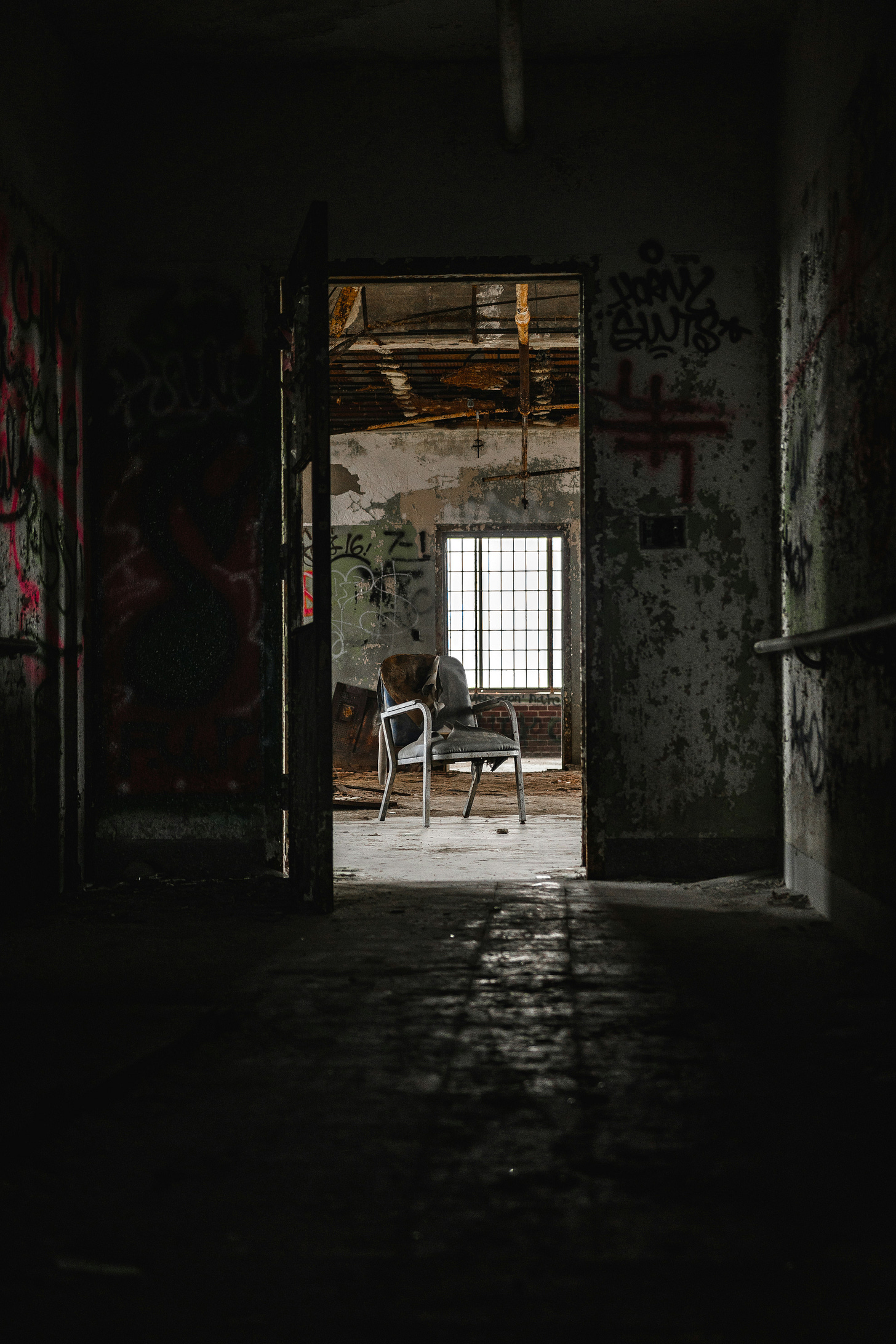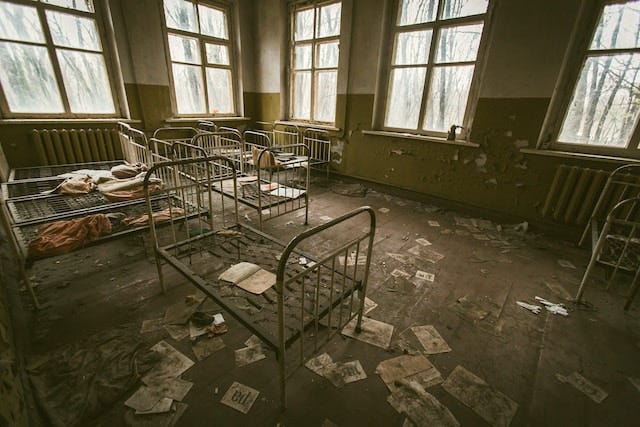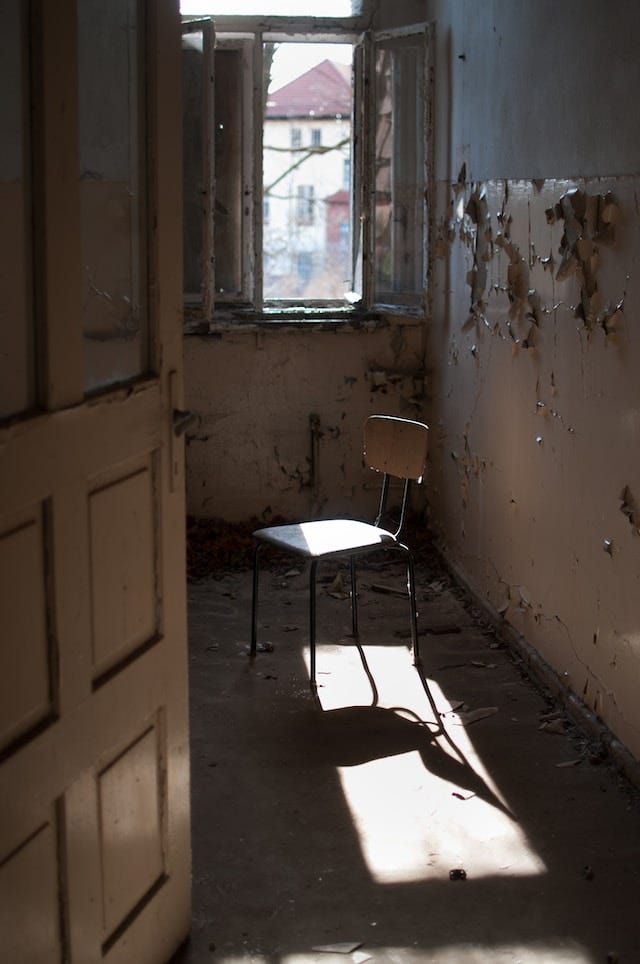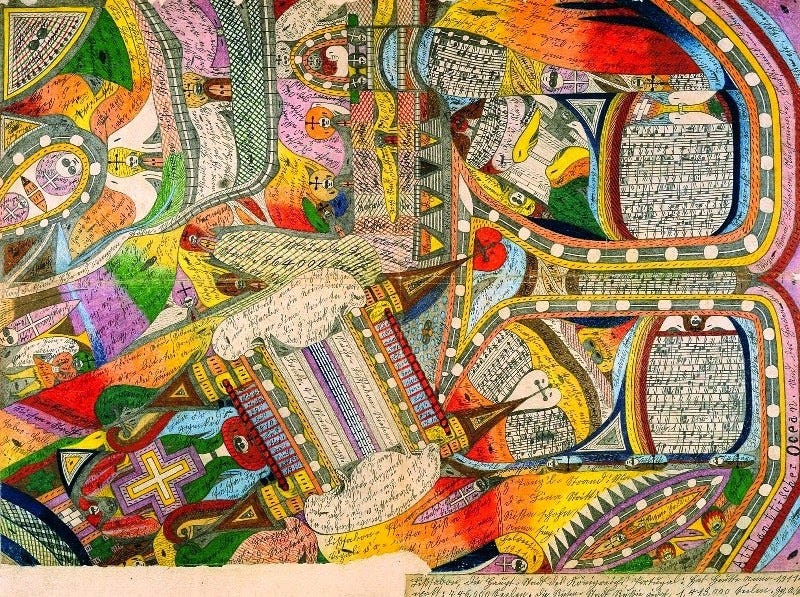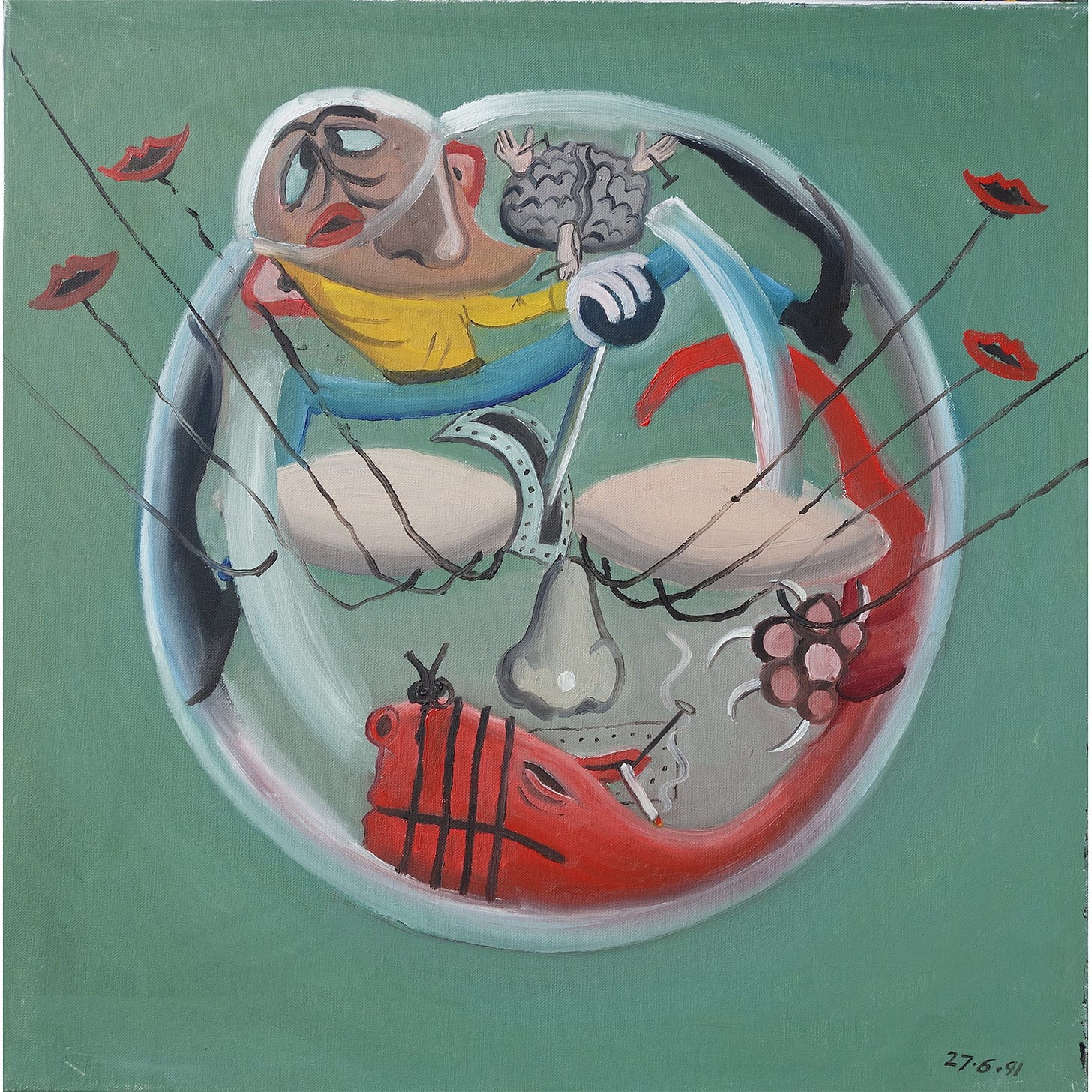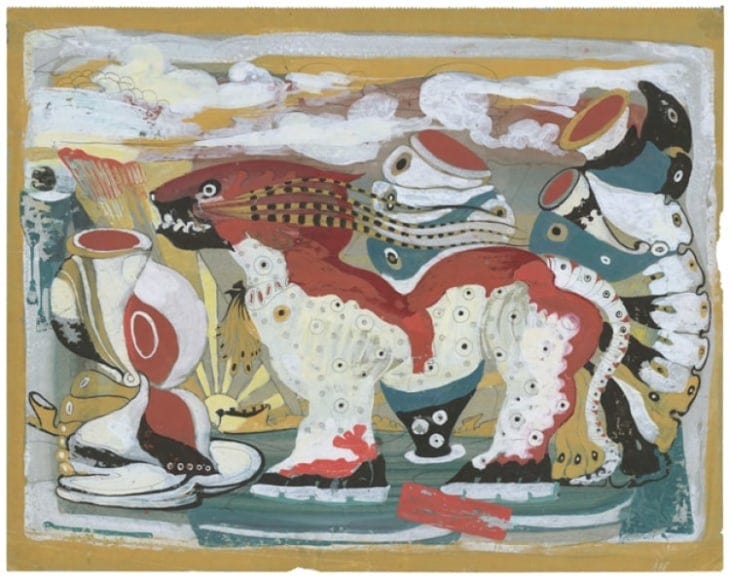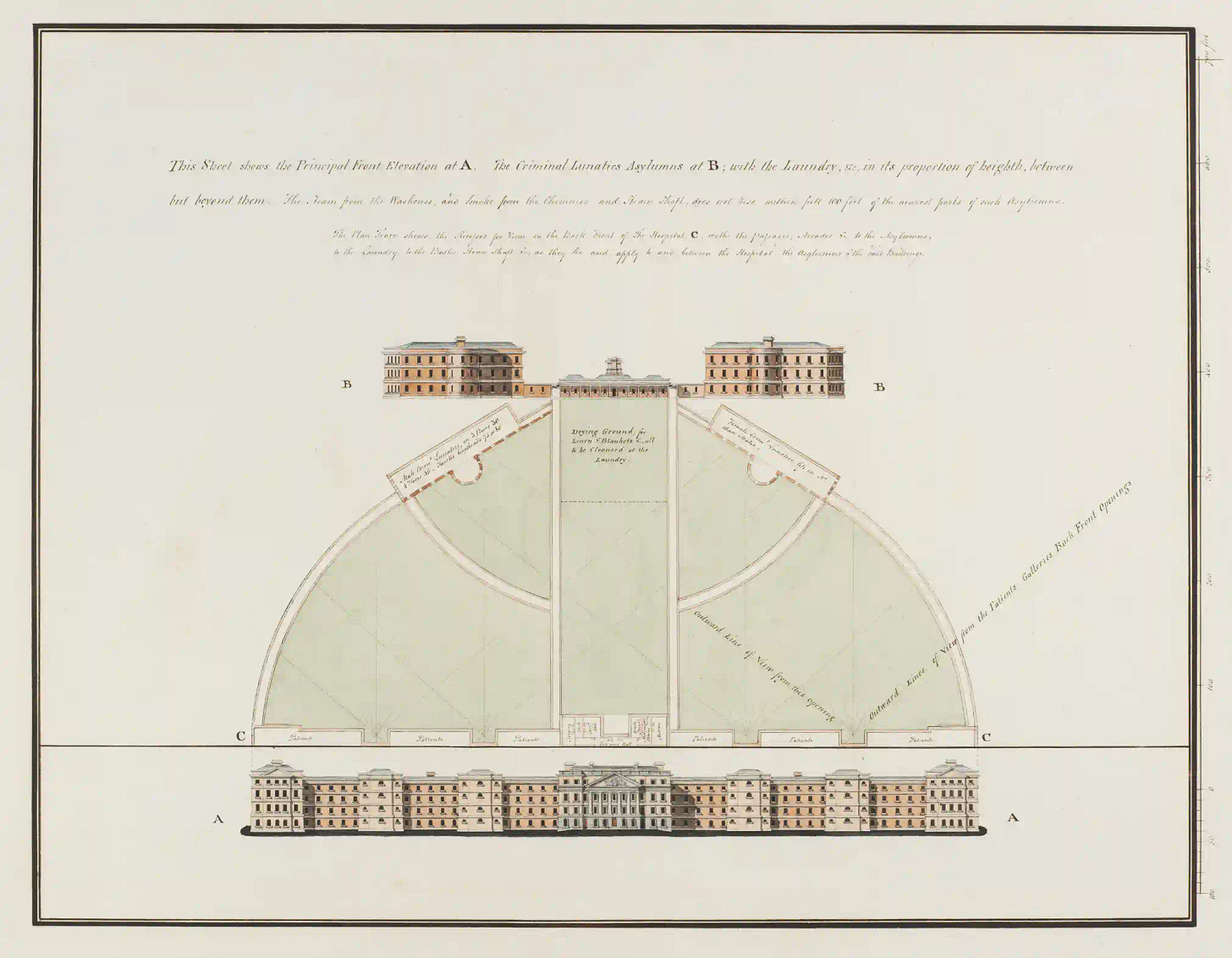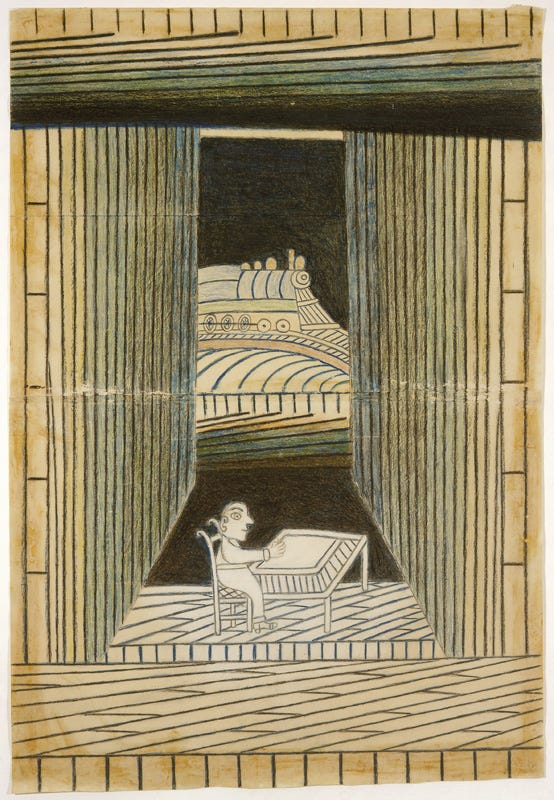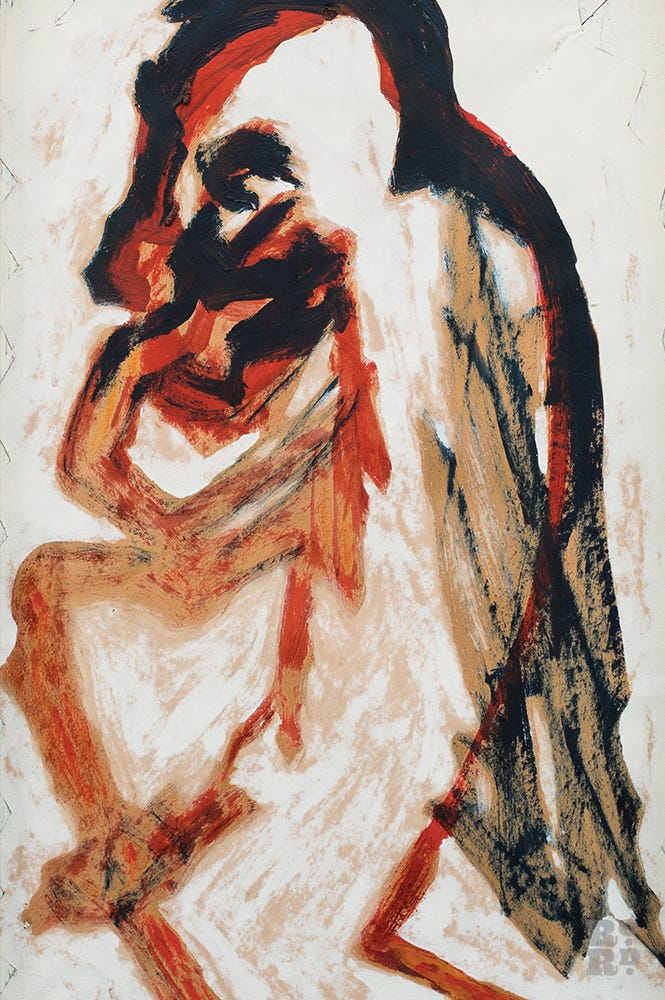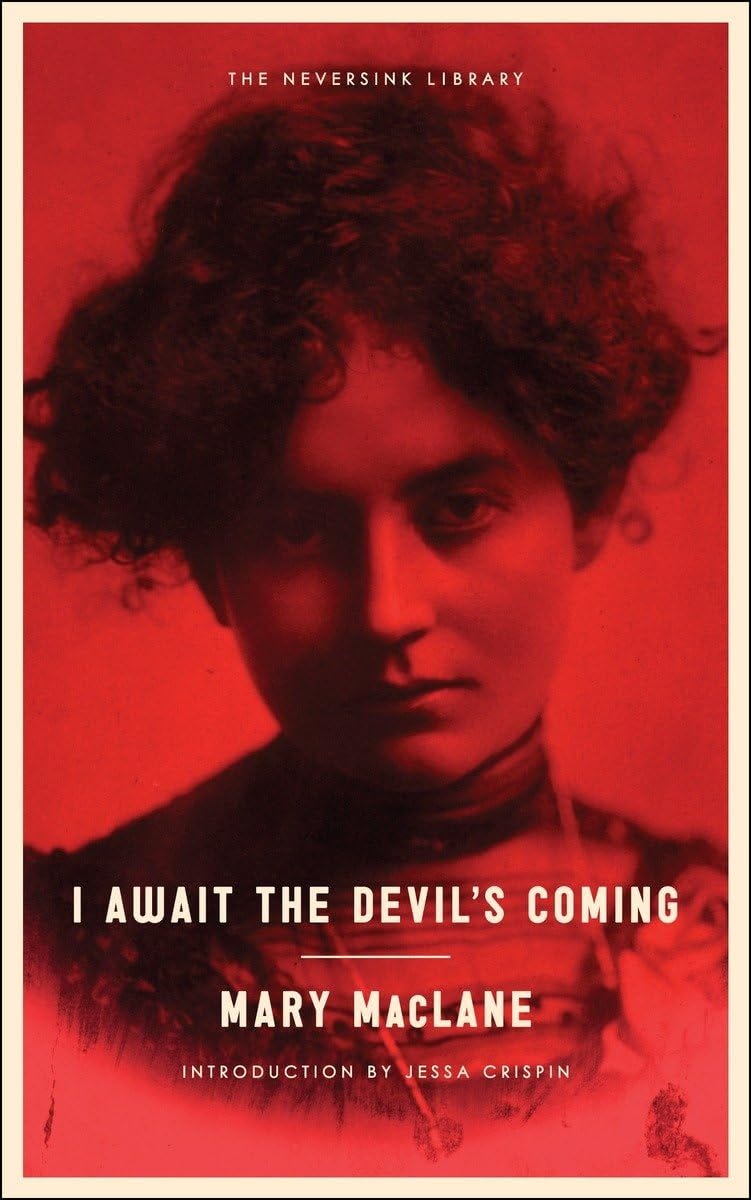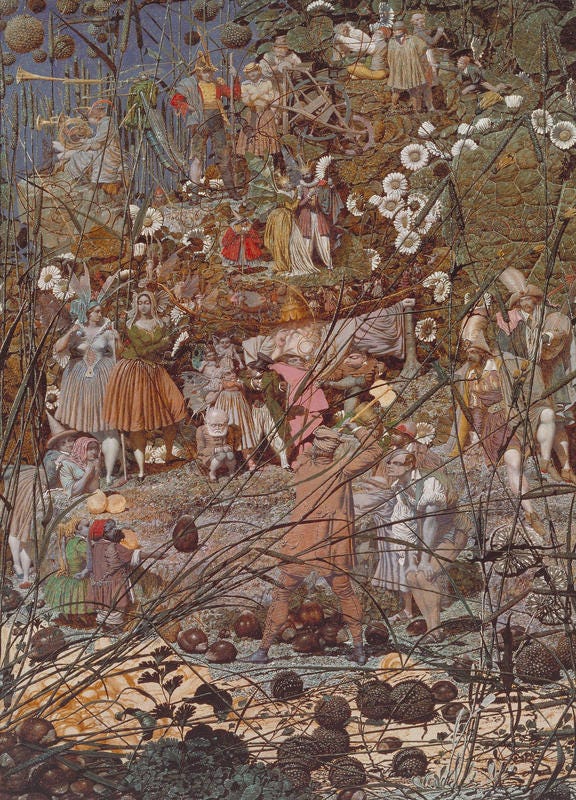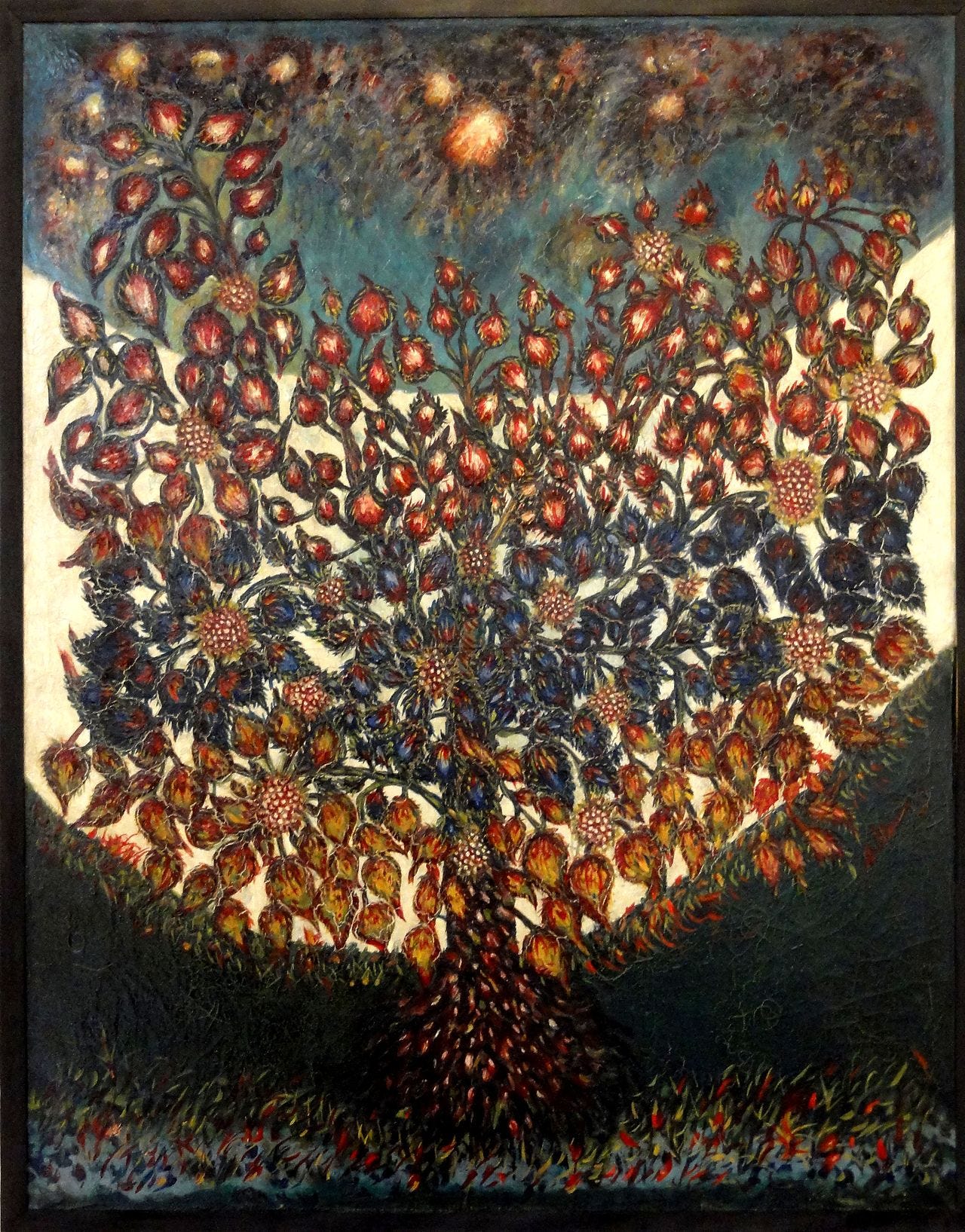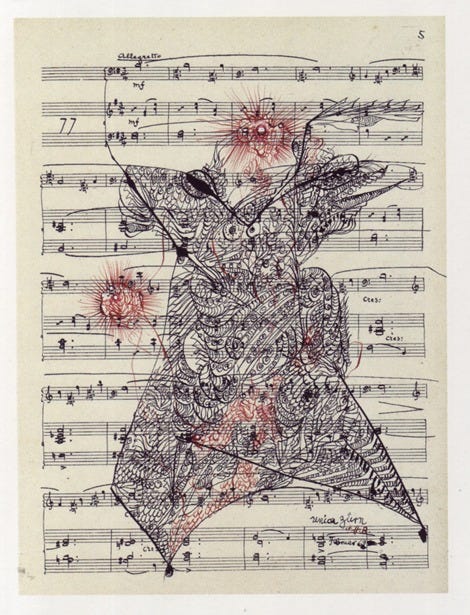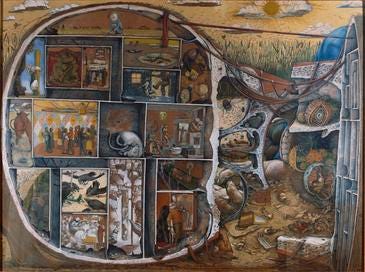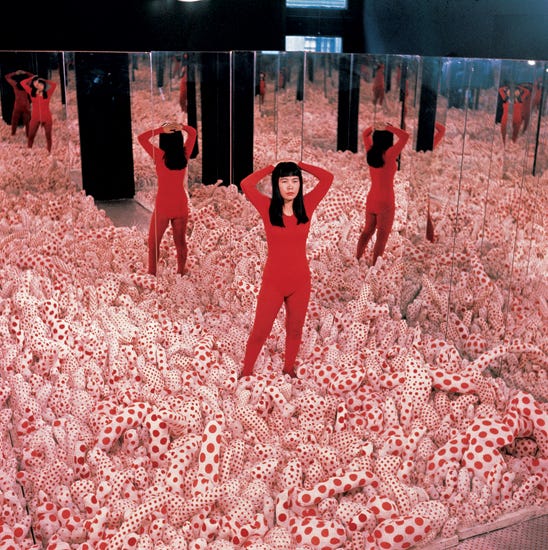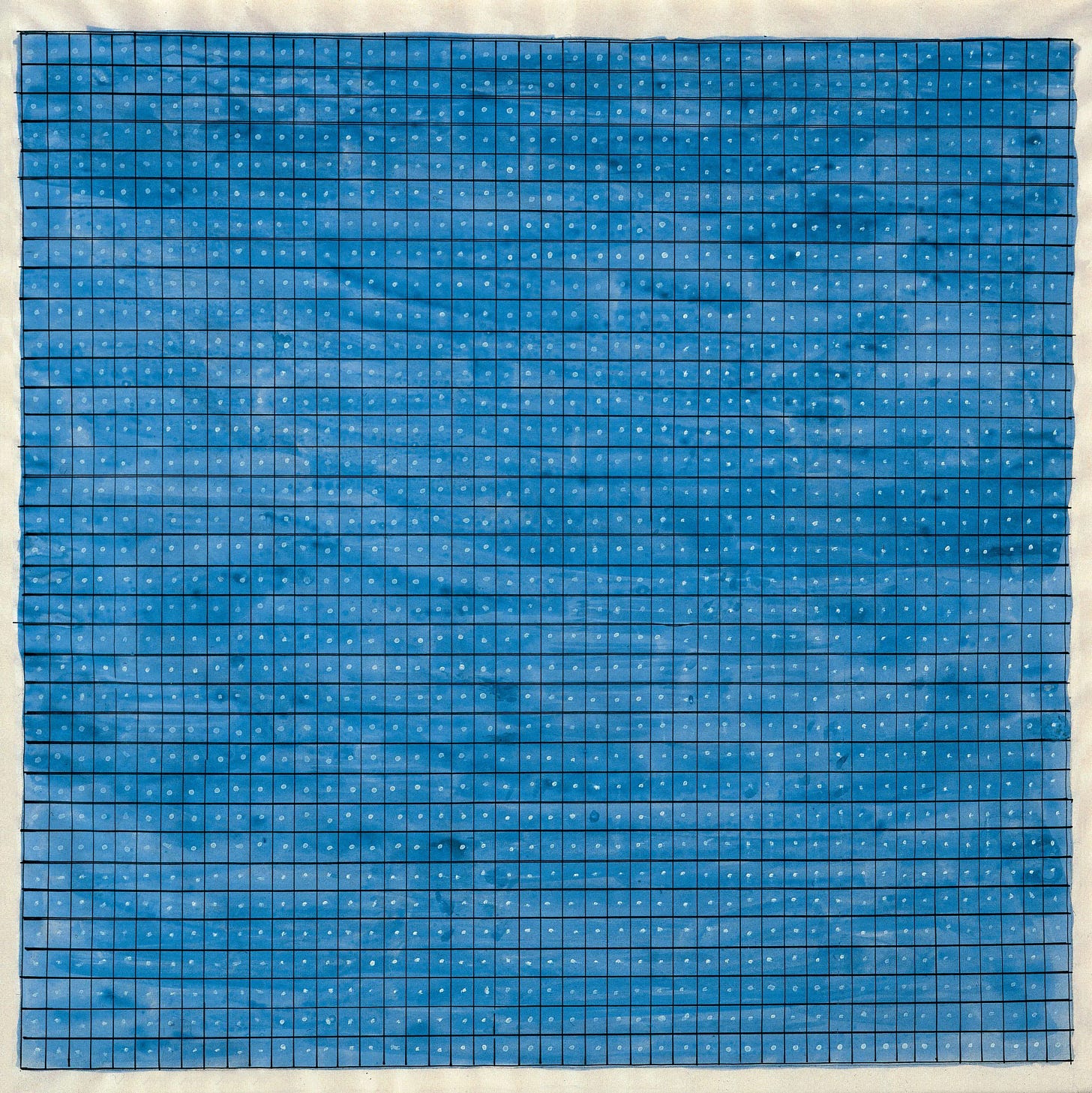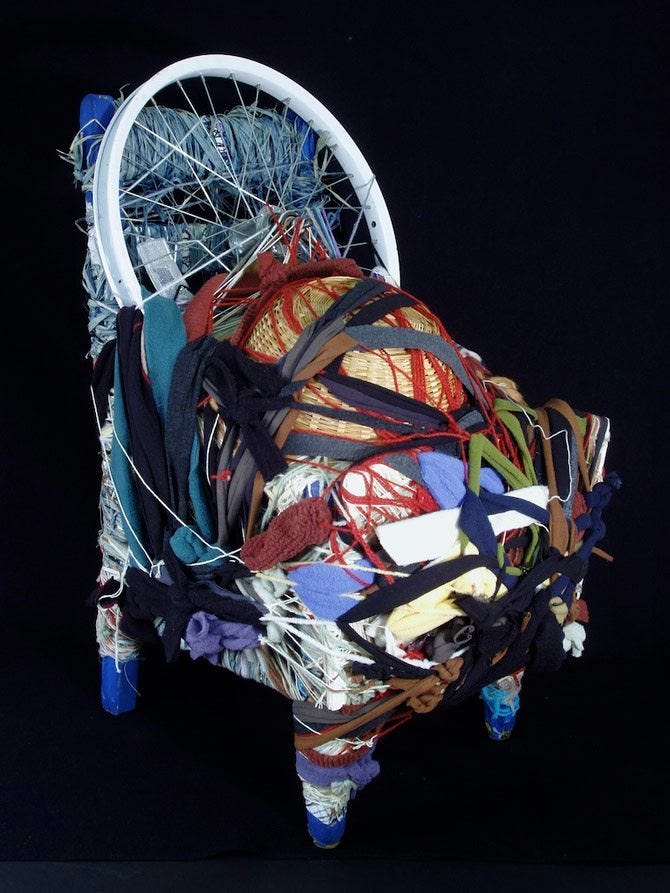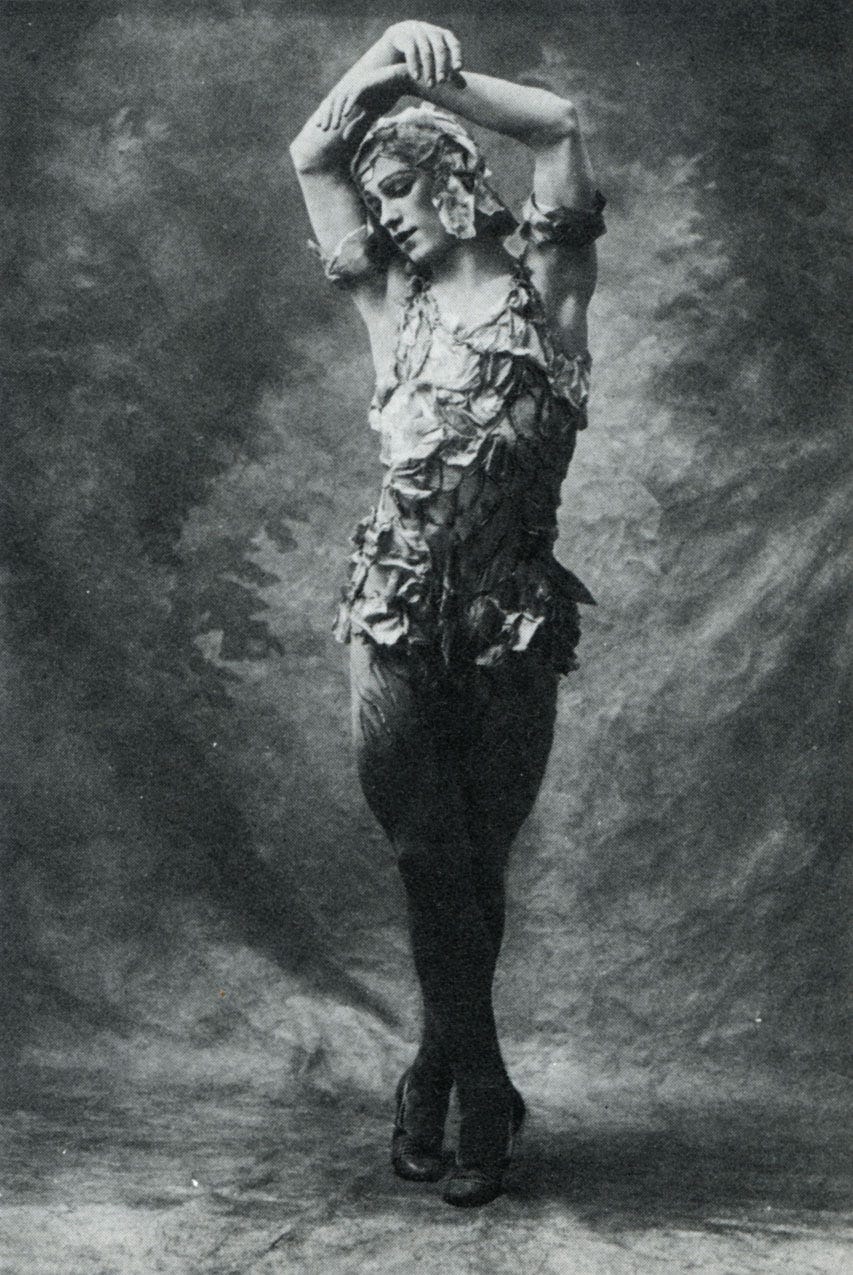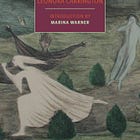Asylum Art: Artists Who Created While Living in Psychiatric Institutions (And Those Who Did Not)
Aloise Corbaz, Barbara Suckfull, Bryan Charnley, Camille Claudel, Louis Wain, Martin Ramirez, Unica Zurn and more than a dozen other artists who did and didn't create while in inpatient care
I have developed these ideas after decades of lived experience, interview-based insights, and deep research into the complex relationship between art and health. They are based on my unique 6-part framework. If you are interested in assistance in applying these ideas to your own life: Order a Creative Health Assessment or Book a 1:1 Coaching Call.
When you think about artists who created from inside the walls of a psychiatric institution, who comes to mind? Van Gogh is the most famous example, and the one that many people name first. People interested in contemporary art and women artists may instead first name Yayoi Kusama. These are just two examples of many creative people who have created asylum art.
History of Asylum Art: Ebbs and Flows
The history of patients being allowed to or restricted from creating art within institutionalized settings is complex and varies greatly depending on the period, place, and specific institution. Broadly speaking, the use of art in therapeutic contexts dates back to antiquity, but its formal recognition and widespread implementation is more recent.
In the late 19th and early 20th centuries, there was limited understanding and acceptance of the therapeutic potential of art. Some psychiatric institutions may have allowed patients to draw or paint as a form of distraction or simple occupation, without necessarily recognizing the therapeutic value. However, the situation varied greatly. Some institutions might have imposed strict rules and restrictions on patients' activities, including creative expressions.
Consider, for example, the history of hysteria and neurasthenia and the "rest cure." Consider the example of Leonora Carrington and the question of whether a compassionate art therapy approach to her institutionalization would have made a difference in her work and mental health.
Art Therapy In Psychiatric Institutions
The situation started to change in the mid-20th century with the development of the field of art therapy. In the wake of World War II, therapists started recognizing the potential of art as a therapeutic tool. Adrian Hill, a British artist who was hospitalized during the war, is often credited as the father of art therapy. He noticed that drawing and painting had a therapeutic effect on him and began to use art with other patients.
Since the establishment of the American Art Therapy Association in the 1960s, the field has grown in recognition and professionalism. Art therapy is now widely recognized as a form of psychotherapy, and the rights and needs of patients to engage in artistic expression are more widely accepted.
Nowadays, many psychiatric institutions actively encourage patients to engage in artistic activities, not just as a form of occupational therapy, but as a genuine form of expression and a way to improve mental health. Art programs in hospitals and therapeutic settings are not uncommon, and there is a substantial body of research demonstrating the efficacy of art therapy in various contexts. Still, it's important to note that the extent to which patients are allowed to create art can still vary depending on the institution, the specific rules in place, and the condition of the patient.
Asylum Art in Art History and Contemporary Art Market
The recognition of artwork produced within psychiatric institutions has been a complex process, deeply intertwined with societal attitudes towards mental health and the boundaries of what constitutes art. Historically, such art was often disregarded, undervalued, or exoticized due to prejudices about mental health. However, changes over time have led to a greater appreciation of these works and their creators. Here are some significant movements and trends:
Art Brut/Outsider Art
The term "Art Brut" (raw art) was coined by French artist Jean Dubuffet in the mid-20th century to describe art created outside the boundaries of the official culture, including works produced by self-taught artists, psychiatric patients, and others on the margins of society. Dubuffet amassed a large collection of such works, which he saw as a potent source of raw creativity unspoiled by academic art traditions. The collection is now housed in the Collection de l'Art Brut in Lausanne, Switzerland. The term "Outsider Art" was later introduced as an English equivalent. It's been a problematic term for many reasons, which I cover a bit in my book The Artist's Mind.
Prinzhorn Collection
A key development in the recognition of art from psychiatric patients was the Prinzhorn Collection. In the early 20th century, psychiatrist and art historian Hans Prinzhorn collected around 5,000 works of art created by psychiatric patients from various European hospitals. His 1922 book "Artistry of the Mentally Ill" influenced the perception of these artworks, arguing for their aesthetic value rather than viewing them solely as clinical symptoms. This is where I learned a lot about asylum art and artists who created in institutions.
Interest from Modern Artists
Artists such as Paul Klee and Max Ernst found inspiration in the works from the Prinzhorn Collection, appreciating the raw emotion and unconventional perspectives they embodied. This recognition from established artists helped to shift public perception and stimulate interest in the field.
Popularity of Outsider Art
Since the 1970s, there has been a growing interest in and market for "Outsider Art". Outsider Art fairs and galleries have been established in several countries, and works by such artists are now featured in the collections of major museums. Again, there's a lot of controversy around this. There are pros and cons. It's a complicated issue.
Contemporary Art World Recognition
Today, there are numerous contemporary art projects and exhibitions that feature or focus on art from psychiatric institutions or created by artists with mental health issues. An example is the Venice Biennale, one of the most important international contemporary art exhibitions, which has included such artists.
The value and status of art produced within institutions have evolved significantly and will likely continue to do so. However, this field also raises complex ethical issues around exploitation, representation, and consent, which continue to be debated among critics, scholars, and within the art market.
Artists Who Created From Inside Mental Health Institutions
Like with seemingly every topic related to artists and mental health, Van Gogh's name often arises first. He's certainly one of the most famous artists to have created from inside of an asylum. And one of his most famous paintings, Starry Night, is among his asylum paintings. Van Gogh had famously cut off his ear, shortly after which he checked himself into a small private asylum called Saint-Paul-de Mausole.
While there were times there that he was incapacitated and not creating, there was also much time when he was painting, often working in the fresh air of the garden. Irises, Wheatfield with Cypresses, and Women Picking Olives are among the nature-inspired works painted during his time there. But perhaps most poignant is Corridor in the Asylum, which depicts the life he experienced while living inside its walls.
Here are some other the other artists who created from inside mental health institutions.
Adolf Wölfli
Adolf Wölfli (1864–1930) was a Swiss artist associated with the Art Brut or outsider art movement. Wölfli was orphaned at a young age and suffered multiple personal traumas, leading to sporadic bouts of violent behavior. As a result of these incidents, he was committed to the Waldau Clinic, a psychiatric hospital in Bern, in 1895, where he spent the remainder of his life.
It was at the Waldau Clinic that Wölfli began to draw, initially as a method of self-soothing. His doctors soon noticed his prolific creativity, and his general practitioner, Walter Morgenthaler, published a book about him, "Ein Geisteskranker als Künstler" (A Psychiatric Patient as Artist), which brought Wölfli's work to the attention of the art world.
Wölfli's output was vast and complex, comprising a cosmology detailed in a series of books that included an imaginary autobiography, narrative prose, poetry, musical compositions, and elaborate, intricate drawings. The drawings often incorporated words and musical notations, filled with geometric patterns, swirling forms, and fantastical creatures.
Aloise Corbaz
Corbaz's journey into art began in her mid-30s when she was admitted to the La Rosière psychiatric hospital in Switzerland. During her time there, she began to create vivid and elaborate drawings and collages. Her art often depicted romantic and royal figures, as well as scenes inspired by her own delusional beliefs and fantasies.
Corbaz's artistic style was characterized by bold, vibrant colors and intricate detailing. She used a combination of mediums such as pencil, ink, and watercolor to bring her imaginative world to life. Her works were often large-scale, and she used every available space on the paper, densely filling it with figures, patterns, and text.
The themes in Corbaz's art frequently revolved around her romantic fantasies, in which she believed herself to be in a love affair with a high-ranking German officer, Prince Eisenhohenzollern. Through her art, she created a vivid world where she was the beloved queen and surrounded by opulence and adoration.
Corbaz's artwork remained largely unknown during her lifetime. However, after her death in 1964, her vast collection was discovered and recognized for its artistic and emotional power. Her works have been exhibited in major museums and galleries worldwide, showcasing her unique artistic vision and the complex inner world she captured on paper. Aloise Corbaz's art stands as a testament to the resilience of creativity in the face of adversity.
Antonin Artaud
French dramatist, poet, essayist, actor, and director Antonin Artaud (1896–1948) spent a significant portion of his life in psychiatric institutions. Artaud had a long history of mental health issues, which were exacerbated by his addiction to laudanum, a tincture of opium. His condition became more severe over time, and he was diagnosed with various conditions, including depression and schizophrenia.
Artaud's most extended hospitalization began in 1937, when he was declared mentally ill after a series of increasingly erratic and disturbing behaviors. He was committed to various asylums in France over the next nine years, including the infamous Rodez asylum. During this period, he continued to write a substantial amount of material, including poems, essays, and letters. These writings are notable for their rawness and intensity, often reflecting Artaud's anguish, despair, and anger at his situation. They also reveal his ongoing preoccupation with themes of suffering, cruelty, and the limitations of perception and understanding.
August Natterer
Originally trained as an engineer, Natterer's life took a dramatic turn when he started experiencing hallucinations and delusions. These episodes culminated in a psychotic episode on April Fool's Day in 1907, during which he believed he had a pivotal vision of the "Last Judgment". Shortly thereafter, Natterer was diagnosed with schizophrenia and institutionalized for most of the rest of his life.
During his time in various psychiatric hospitals, Natterer began to create art. He had no formal training as an artist, but he produced a large body of work, primarily drawings. Natterer's artworks were intricate and full of symbolic, mythical, and religious imagery that seemed to be influenced by his hallucinations and delusions. Many of his works are notable for their meticulous detail, intricate patterns, and the fantastical, often apocalyptic themes they explore.
Barbara Suckfull, Prinzhorn
Giovanni Frazzetto writes:
"Drawings and an installation by contemporary artist Peter Riek revive the story of farmer Barbara Suckfull, who, at the age of 50, started to hear voices. In 1910, under their command, she began to draw outlines of dishes and cutlery. Writing along and in between the outlines, Suckfull captures in words her everyday life in the Heidelberg asylum: what she thought, did or ate, her rows with the nurses and what the voices told her. Every word is followed by a full stop, resulting in a dense net of marks that dissolves into abstraction."
Bryan Charnley
Bryan Charnley (1949–1991) was a British artist known for his powerful and introspective artwork, which explored his personal experiences with schizophrenia and the effects of medication. Born in Lancashire, England, Charnley began his artistic pursuits at a young age.
Charnley's artistic journey took a significant turn in the late 1970s when he started experiencing symptoms of schizophrenia. He began documenting his psychological state through self-portraiture, using art as a means of understanding and expressing his experiences with mental illness.
His self-portraits often depicted distorted and fragmented faces, reflecting the inner turmoil and fragmentation of his own identity caused by the illness. Charnley used bold colors and expressive brushwork to capture the emotional intensity of his mental health struggles. He portrayed the experiences and side effects of medication on his mental state as well as the experience of the mental condition itself. His work showcases his fragmented self-image, the loss of identity, and the dichotomy between the desire for stability and the potential negative impacts of medication.
Charnley's art offered a unique and intimate perspective on the subjective experience of living with schizophrenia. He aimed to challenge stereotypes and stigma surrounding mental illness, inviting viewers to engage with the complexity of his internal world. He died by suicide in 1991; four years later his self-portraits were placed on exhibit.
Camille Claudel
Camille Claudel (1864–1943) was a talented French sculptor and graphic artist known for her expressive and emotionally charged works. Despite her undeniable talent, Claudel’s life and career were marked by struggle, largely due to societal norms and her complex relationship with renowned sculptor Auguste Rodin, her lover and mentor.
In 1913, following the death of her father and an intensification of her symptoms of psychological distress, Claudel was committed to a psychiatric institution by her brother, poet Paul Claudel. Despite occasional periods of lucidity and pleas for release, she remained institutionalized for the rest of her life, spanning 30 years, first in Ville-Evrard in Neuilly-sur-Marne and later in the Montdevergues Asylum in Montfavet near Avignon.
While Claudel created a handful of sculptures and drawings during her early years at Ville-Evrard, the increasingly restrictive environment at Montdevergues and the gradual withdrawal of her art materials led to an eventual cessation of her artistic output. Much of her work from this period, and her earlier work as well, was tragically destroyed, either by Claudel herself in fits of frustration or by the institutions in which she was housed.
Eugène Gabritschevsky
Eugène Gabritschevsky (1893–1979) was a Russian-born artist and biologist who created a significant body of artwork while living in psychiatric hospitals. Gabritschevsky's life and artistic career were profoundly influenced by his struggles with mental illness and his unique perspective as a scientist-turned-artist.
Gabritschevsky initially trained as a biologist and earned a doctorate in zoology. However, in the 1930s, he began exhibiting signs of mental illness and was diagnosed with schizophrenia. His condition worsened, leading to his institutionalization in various psychiatric hospitals for much of his life.
During his time in psychiatric care, Gabritschevsky turned to art as a means of self-expression and exploration. He primarily focused on drawing and painting, creating works that delved into his inner world and reflected his experiences with mental illness.
Gabritschevsky's art often featured organic, biomorphic forms, distorted figures, and vibrant colors. His works revealed a fascination with biology and the natural world, blurring the boundaries between human, animal, and plant forms. He often combined scientific and artistic elements, incorporating intricate details and precise brushwork into his compositions.
James Tilly Matthews
According to The Guardian:
"In 1810, Bethlem launched a public competition to design a new hospital building, and James Tilly Matthews, confined there since 1797, offered up his own suggestions. In notes alongside his designs, he argues that inmates should be able to grow vegetables, look after the sick and help with chores."
Louis Wain
Louis Wain was a talented English artist known for his idiosyncratic illustrations of anthropomorphized large-eyed cats. His works gained considerable popularity during the late 19th and early 20th century.
By the 1920s, Wain's deteriorating mental health led him to be institutionalized. His life in the asylum wasn't easy, but it did contribute to a significant evolution in his artwork. While living in the asylum, Wain continued to create, his art providing a therapeutic outlet for his troubled mind. His cat illustrations became more abstract, intricate, and psychedelic, reflecting the shifts in his mental state.
The hallucinatory, vibrant kaleidoscopic patterns of his later works suggested a world seen through a schizophrenic lens. Some observers theorize that Wain's evolving style and use of color were influenced by his mental condition, although the relation between schizophrenia and artistic style is not universally agreed upon.
Many of his later works can be described as "kaleidoscopic" – complex, multi-colored, and almost fractal-like depictions of cats. These pieces often fill the entire canvas with intricate, swirling patterns that could be interpreted as a representation of the artist's disturbed mental state.
It's important to note that the ordering and dating of Louis Wain's works, especially those created during his time in the asylum, are a matter of debate among scholars and art historians. The 'progression' from more 'normal' cat pictures to the psychedelic ones is often presented as a direct mirror to his mental health deterioration, but some argue that this is an oversimplification.
Martín Ramírez
Martín Ramírez, a self-taught artist, spent much of his life in psychiatric institutions. He was born in Mexico in 1895 and migrated to the United States in the 1920s in search of work. In 1931, he was diagnosed with schizophrenia and subsequently institutionalized for the rest of his life, first at Stockton State Hospital and later at DeWitt State Hospital, both in California.
Despite his challenging circumstances, Ramírez produced a large body of artwork during his time in these institutions. His 300+ works, often created with makeshift materials like paper bags and book pages glued together with a paste made of bread and saliva, are characterized by detailed and intricate patterns. His drawings typically depict themes from his memories and experiences, including landscapes, animals, religious imagery, and trains, often framed within a network of repeating lines and shapes.
Ramírez's art was largely unknown during his lifetime, but his works were discovered by a psychologist at DeWitt State Hospital.
Mary Barnes
Mary Barnes, who had been diagnosed with schizophrenia, is known for creating a significant body of artwork while living in an experimental therapeutic community, Kingsley Hall, in London, England.
Barnes was a British artist and writer who, in the 1960s, voluntarily admitted herself into Kingsley Hall, a residential treatment facility for people with mental health issues run by the famous Scottish psychiatrist, R. D. Laing. There, Laing promoted a radical non-restrictive approach, creating an environment where residents were free to explore their mental conditions without traditional psychiatric intervention.
During her stay at Kingsley Hall, Barnes engaged in an intense therapeutic relationship with the art therapist, Joseph Berke. She began to paint as part of her therapy and started producing artwork prolifically, creating a large body of expressive and powerful paintings.
Her works often depicted her mental states, including terrifying hallucinations and experiences from her past. Barnes' artistry wasn't limited to painting, however. She also wrote extensively about her experiences, and her writings, together with her artwork, provide a deep and poignant account of her journey through mental illness and recovery. After leaving Kingsley Hall, Barnes continued to work as an artist and advocate for mental health.
Mary MacLane
Mary MacLane, an American writer, gained fame for her confessional and introspective style of writing. She struggled with mental health issues throughout her life and was institutionalized on multiple occasions. However, she did not stop writing during these periods.
While in institutions, MacLane continued to express herself through her writing. Her works often delved into her personal thoughts, emotions, and experiences with mental health. In fact, it was during her time in an institution that she wrote one of her most famous works, "I Await the Devil's Coming." This memoir showcases her raw and provocative writing style, providing a candid exploration of her mental state and societal expectations.
MacLane's writings, both before and during her stays in institutions, challenged conventional norms and explored themes of self-discovery, desire, and the struggles of a young woman navigating societal expectations. Her unique voice and unfiltered introspection continue to resonate with readers today.
Richard Dadd
Dadd is one of the most interesting institutionalized artists I've studied. I'm not sure I fully understand his work, but I discover a lot there to explore each time I review it again.
He was an English Victorian painter known for his exceptional attention to detail and fantastical subject matter, often featuring fairies and other mythical beings. His life took a tragic turn in 1843 when, during a tour of the Middle East, he started exhibiting signs of severe mental distress, possibly schizophrenia, leading him to murder his father in the belief that he was the devil. From 1844 until his death in 1886, Dadd was confined in the Bethlem Hospital, also known as Bedlam, and later transferred to the newly opened Broadmoor Hospital, both psychiatric institutions.
Despite the drastic changes in his circumstances, Dadd continued to paint during his confinement. His asylum works are notable for their intricate details and imaginative subject matter. They often depicted fairy-folk and other mythological creatures set against lush landscapes. While Dadd's illness undeniably caused him significant distress, it didn't curtail his artistic abilities, but rather seemed to fuel his imagination and creativity.
Among his most recognized works created during his institutionalization is "The Fairy Feller's Master-Stroke" (1855-1864), an intricate painting filled with tiny, detailed figures in a woodland setting. The work was based on a poem that Dadd wrote, explaining each of the figures in the scene. Dadd spent nine years working on this painting, using a layering technique to add depth and richness to the piece.
Séraphine Louis
Séraphine Louis, also known as Séraphine de Senlis, was a French painter born on September 3, 1864, in Arsy, France. She is recognized as an outsider artist, characterized by her unique and visionary style. Séraphine's life and artistic career were marked by struggle, obscurity, and a deep connection to nature.
Séraphine worked as a domestic servant in various households before being discovered by Wilhelm Uhde, a German art collector and critic, in 1912. Uhde recognized her talent and became her patron, providing her with art supplies and support. Séraphine primarily painted with oil on canvas, and her works often depicted vibrant floral still lifes, mystical landscapes, and religious themes.
Her artistic process was deeply connected to her spiritual beliefs and the natural world. Séraphine claimed to receive her artistic inspiration directly from divine sources, particularly from the Virgin Mary and angels who communicated with her. She would gather natural pigments and dyes from plants and use unconventional materials such as candle wax to create her paintings.
Despite her talent and brief recognition in the art world, Séraphine's mental health began to deteriorate. With the outbreak of World War I and the financial hardships that followed, her relationship with Uhde ended, leaving her without the necessary support to continue her artistic practice. Séraphine was eventually admitted to a psychiatric hospital in 1930 and spent the rest of her life there.
Séraphine Louis continued to create artwork even while she was in the psychiatric hospital. However, her access to art supplies and materials was limited compared to earlier in her life when she had the support of Wilhelm Uhde, her former patron.
During her time in the hospital, Séraphine improvised and used whatever materials she could find. She often painted on small, irregularly shaped pieces of paper or cardboard, using homemade paints and pigments. She would crush flower petals, use candle wax as a binding agent, and sometimes mix her paints with blood or saliva. These unconventional techniques and materials added a unique and raw quality to her artwork.
Séraphine's paintings from her time in the hospital maintained her characteristic style, often depicting floral still lifes with rich colors and intricate details. Despite the challenging circumstances, her commitment to art remained strong, and she continued to create works that reflected her deep connection to nature and her spiritual beliefs.
It's important to note that Séraphine's artistic production significantly declined during her time in the hospital due to the limitations imposed by her mental health condition and the institutional environment. However, the few paintings she created during that period still showcased her exceptional talent and artistic vision.
Unica Zurn
Zürn's artistic journey began in the 1950s when she became involved with the Surrealist circle in Paris. She was known for her automatic drawings, a technique where she would let her hand move freely across the paper, allowing her unconscious mind to guide the creation. Her drawings often featured delicate, intricate lines and swirling patterns, exploring themes of sexuality, identity, and the hidden realms of the psyche.
Zürn also wrote extensively, publishing poetry, prose, and memoirs. Her writing often intertwined with her art, reflecting her inner turmoil, vivid imagination, and personal experiences. She explored themes of love, desire, madness, and the complexities of the human condition.
Throughout her life, Zürn struggled with mental health issues, including schizophrenia and depression. She was hospitalized multiple times in psychiatric institutions due to her deteriorating mental state. Despite her challenges, Zürn continued to create art and write, finding solace and expression in her creative endeavors.
William Kurelek
William Kurelek (1927–1977) was a Canadian artist and writer. His artwork is well-known for its realistic style, detail, and often religious and social commentary. Kurelek did spend time in psychiatric hospitals in the UK and Canada in his early adulthood, and he began creating art during his treatment, which played a significant role in his recovery.
While at the Maudsley Hospital in London, Kurelek was encouraged by his doctor to continue painting as part of his treatment. His mental health struggles and experiences in these institutions influenced his art deeply.
One of his notable works from this period is "The Maze", a disturbing self-portrait depicting his skull filled with imagery reflecting his tortured thoughts and feelings. The painting was created while Kurelek was a patient at the Maudsley Hospital. It provides a visceral illustration of the despair and inner turmoil he experienced during his mental health crisis.
After his hospitalization, Kurelek returned to Canada and continued his career as an artist, producing a significant body of work.
Yayoi Kusama
Kusama is perhaps one of the most famous contemporary artists to create work from inside of a psychiatric setting. Born in 1929 in Japan, has experienced mental health struggles throughout her life, which led to her voluntary admission to a psychiatric hospital in Tokyo in the 1970s. Her decision to seek psychiatric care was influenced by her ongoing battle with hallucinations and anxiety.
Kusama has stated that she began experiencing vivid hallucinations from a young age, seeing repetitive patterns and dots covering her surroundings. These experiences, along with her obsessions and anxieties, greatly influenced her art. Her time in the hospital allowed her to receive treatment and find solace in creating art as a form of self-expression and therapy.
While in psychiatric care, Kusama continued to produce an extensive body of work. Her art from this period often explored her recurring motifs, such as polka dots, infinity nets, and mirrored environments. These repetitive patterns reflected her psychological state and obsessions.
One of her notable works created during her time in the hospital is "Infinity Mirrored Room - Phalli's Field" (1965). This installation consisted of a small room covered in mirrors and filled with hundreds of phallic-shaped soft sculptures adorned with polka dots. It was one of the earliest iterations of her immersive and mirrored environments.
Kusama's experiences in the hospital and her subsequent artwork gained international recognition, leading to her emergence as a prominent figure in the art world. Her works created during her time in psychiatric care showcase her unique artistic vision, merging her mental health experiences with concepts of infinity, repetition, and the exploration of the self.
Artists Who Didn't Create During Times of Hospitalization
Of course, there are plenty of artists who have spent time under psychiatric care and didn't create art (or art that we as the public are aware of) during that time. This can be due to the rules of the institution. It can be due to the symptoms of the condition. Here are some examples:
Agnes Martin
Agnes Martin (1912–2004) was a Canadian-American abstract painter known for her minimalist, grid-based works. Martin lived with schizophrenia, and she was periodically hospitalized for her condition, particularly during the 1960s
From what is publicly known, Martin did not actively create her renowned paintings during her hospital stays. These periods of hospitalization were times of deep personal struggle, and they correspond with gaps in her artistic output. However, the experiences and introspection during these times deeply influenced her work.
Martin's approach to her work was deeply philosophical. She sought to express abstract emotions and states of mind in her art, aiming to evoke sublime and serene responses. Her experiences with mental illness influenced her work, contributing to the depth and emotional resonance of her minimalist compositions.
It's worth noting that following her hospitalizations in the 1960s, Martin took a hiatus from painting for several years. She traveled throughout the United States and Canada before settling in New Mexico, where she eventually returned to painting and developed the minimalist, grid-based style that she is best known for today.
Judith Scott
Judith Scott (1943–2005) was an American fiber artist known for her intricate and unique sculptures. Born with Down Syndrome, and later becoming deaf likely due to undiagnosed scarlet fever, Scott was institutionalized for 35 years in a state hospital in Ohio. In 1986, her twin sister, Joyce, gained legal custody of her and moved her to California.
Once in California, Scott began attending the Creative Growth Art Center, a professional art studio for adult artists with disabilities. It was here that she discovered her passion and talent for fiber art. The tactile nature of the work, combined with her keen sense of color and form, made this medium a perfect fit for her.
Scott created sculptures by wrapping found objects, such as sticks, wire, and even shopping carts, with layers of yarn, string, fabric, and other fibers. She was highly private about her work, preferring to work alone and often covering her project with a sheet if others were present.
Her creations are often seen as representations of her inner life and experiences. Though Scott was nonverbal, her artwork expresses a powerful personal vision and has been exhibited at museums and galleries around the world.
Unlike many artists who have lived in institutions, Scott's major creative output occurred after she left the state hospital system. Her story is a poignant example of the transformative power of art and the potential that can be unlocked when individuals are provided with the right environment and support.
Rosemary Kennedy
Rosemary Kennedy (1918-2005) was a member of the prominent Kennedy family, known for her intellectual disabilities and the challenges she faced throughout her life. Rosemary was the third child of Joseph P. Kennedy Sr. and Rose Fitzgerald Kennedy and the sister of President John F. Kennedy.
During her early years, Rosemary appeared to be developmentally delayed and struggled academically. As she reached adolescence, her parents became concerned about her behavior and sought medical advice. In 1941, at the age of 23, Rosemary underwent a prefrontal lobotomy, a controversial surgical procedure used at the time to treat mental illness and behavioral disorders.
Unfortunately, the lobotomy had severe and permanent consequences. Rosemary's intellectual functioning declined, and she lost many of her previous abilities. She experienced difficulties with speech, mobility, and overall cognitive function, essentially regressing to a more dependent state. The procedure profoundly impacted her life and her relationship with her family.
Following the lobotomy, Rosemary was placed in various care facilities, including psychiatric institutions. These institutions aimed to provide her with specialized care and support tailored to her needs. However, the specific details about her experiences in these institutions are not widely known, as the Kennedy family maintained a relatively private stance on Rosemary's situation. It is believed that she faced restrictions on artistic expression during her time in institutions, as her family and the medical staff focused more on managing her condition rather than fostering her creative abilities.
Vaslav Nijinsky
Vaslav Nijinsky's time in psychiatric care is a subject that is still shrouded in some mystery and limited documentation. After experiencing a mental breakdown in 1919, Nijinsky was diagnosed with schizophrenia and spent a considerable portion of his later life in psychiatric institutions.
During his time in care, Nijinsky's mental health deteriorated significantly. He displayed symptoms such as hallucinations, delusions, and erratic behavior. It is believed that his condition prevented him from engaging in regular professional dance activities and led to his retirement from the stage.
Nijinsky's time in psychiatric care was marked by a sense of isolation and separation from the world of dance and the public eye. However, the specifics of his daily life and experiences in the institutions remain relatively undocumented. There are few firsthand accounts or records from that period.
You Might Also Like to Read:
I have developed these ideas after decades of lived experience, interview-based insights, and deep research into the complex relationship between art and health. They are based on my unique 6-part framework. If you are interested in assistance in applying these ideas to your own life: Order a Creative Health Assessment or Book a 1:1 Coaching Call.


